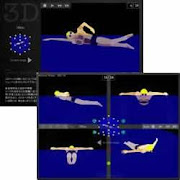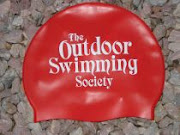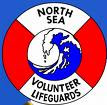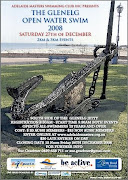 The following CONCLUSION was published in the March 7, 2009 issue of Medicine & Science in Sports & Exercise:
The following CONCLUSION was published in the March 7, 2009 issue of Medicine & Science in Sports & Exercise:"The best position for a draft swimmer was found to be directly behind an active lead swimmer at a distance of 0.50 meters between the toes of lead swimmer and the hands of drafter, with significant reductions in both passive drag and oxygen uptake when drafting."
 The paper was titled Effects of Drafting on Hydrodynamic and Metabolic Responses in Front Crawl Swimming by Mirka Janssen, Barry Wilson, Huub Toussaint.
The paper was titled Effects of Drafting on Hydrodynamic and Metabolic Responses in Front Crawl Swimming by Mirka Janssen, Barry Wilson, Huub Toussaint. Huub is from the Academy for Physical Education, University of Professional Education and Free University's Institute of Fundamental and Clinical Human Movement Sciences in Amsterdam.
 The PURPOSE of the research was to determine the effects of drafting on the hydrodynamic and metabolic responses of the drafter behind and at the side of a passive and an active lead swimmer were related to the influence of a lead swimmer on the flow field of the draftee.
The PURPOSE of the research was to determine the effects of drafting on the hydrodynamic and metabolic responses of the drafter behind and at the side of a passive and an active lead swimmer were related to the influence of a lead swimmer on the flow field of the draftee. The METHODS used in the research included the passive drag of the draft swimmer was compared for the non-drafting condition, in the drafting conditions behind a passive and an active lead swimmer, and at the side of a passive and an active lead swimmer. The effect was also evaluated with oxygen uptake measurements. Fluid pressure measurements were made behind and at the side of a passive and an active lead swimmer to examine the flow field.
 The RESULTS found were as follows: Behind a passive lead swimmer, passive drag was significantly reduced by 20%, and behind an active lead swimmer, it was reduced by 9%. At the side of a passive lead swimmer, passive drag was significantly increased by 9%, and at the side of an active lead swimmer, it increased by 8%.
The RESULTS found were as follows: Behind a passive lead swimmer, passive drag was significantly reduced by 20%, and behind an active lead swimmer, it was reduced by 9%. At the side of a passive lead swimmer, passive drag was significantly increased by 9%, and at the side of an active lead swimmer, it increased by 8%. Oxygen uptake was significantly reduced by 25% behind a passive lead swimmer, by 11% behind an active lead swimmer, and only marginally changed at the side of a lead swimmer. The pressure measurements indicated a 33% decrease in mean flow velocity behind an active lead swimmer but an increase in peak flow velocities due to the kick of the lead swimmer. These increases could explain the lesser decrease in passive drag behind an active versus a passive lead swimmer.
 We greatly appreciate the research published by these esteemed and passionate individuals. While we agree with the CONCLUSION, we have the following comments based on our practical experience and years of observations at ocean swims from Hawaii to California, lake races from Quebec to Switzerland and open water swims from the Mediterranean to Melbourne.
We greatly appreciate the research published by these esteemed and passionate individuals. While we agree with the CONCLUSION, we have the following comments based on our practical experience and years of observations at ocean swims from Hawaii to California, lake races from Quebec to Switzerland and open water swims from the Mediterranean to Melbourne. 1. Without having access to the entire study, we believe the conclusion is valid under the specific circumstance of swimming in a flat-water race in relatively clear conditions in a relatively straight course.
2. The reasons underlying our opinions are based on practical race experience, but we readily admit our conjectures have not yet been objectively proven with scientific measurement devices or strict testing protocols under race conditions:
(a) While the positive draft effect is most helpful when one is swimming right on the toes of a lead swimmer, this position concurrently requires the drafting swimmer to change their optimal head position from looking down to looking up at an angle. We know swimming with your head up at (even a slight) angle is not the most optimal position for a swimmer, especially if the athlete is doing a swim of over 3K.
 (b) While the positive draft effect is most helpful when one is swimming right on the toes of a lead swimmer, if (1) the water conditions are rough, (2) the water clarity is not sufficient or (3) the course is not straight, the drafting swimmer will have to (rather) frequently lift his/her head up to follow the lead swimmer.
(b) While the positive draft effect is most helpful when one is swimming right on the toes of a lead swimmer, if (1) the water conditions are rough, (2) the water clarity is not sufficient or (3) the course is not straight, the drafting swimmer will have to (rather) frequently lift his/her head up to follow the lead swimmer. Because frequently lifting your head up – especially for everyone but the most efficient world-class open water swimmers – will lead to a disadvantage, especially at the end of the race of over 1K.
 (c) Therefore, in a race like the Olympic 10K Marathon Swim in a rectangular course that is clearly identified by buoys and cables, this drafting position is optimal. This is exactly what Larisa Ilchenko, the Russian world and Olympic champion, does so well.
(c) Therefore, in a race like the Olympic 10K Marathon Swim in a rectangular course that is clearly identified by buoys and cables, this drafting position is optimal. This is exactly what Larisa Ilchenko, the Russian world and Olympic champion, does so well.  (d) However, in a roughwater swim in the Pacific Ocean, Atlantic Ocean or in a lake when under windy conditions, we advise athletes to draft just off the thighs or calves of the lead swimmer. This position should be close enough so the drafting swimmer can literally touch both legs of their competitor with their hands at all times.
(d) However, in a roughwater swim in the Pacific Ocean, Atlantic Ocean or in a lake when under windy conditions, we advise athletes to draft just off the thighs or calves of the lead swimmer. This position should be close enough so the drafting swimmer can literally touch both legs of their competitor with their hands at all times. While this 'side draft' does not give as much benefit of the 'rear draft', this 'side' position does allow swimmers to swim more efficiently and not lift up their heads as often (think of Olympic sprinter Jason Lezak in the 400 freestyle relay at the Beijing Olympics).
(e) In really roughwater conditions in the ocean where there are swells or significant surface chop, the optimal position may be to be on the 'protective' side of the lead swimmer. That is, if the waves are coming in from the right, then the drafting swimmer can optimally swim on the left of the lead swimmer. Of course, if one is swimming directly into the waves or surface chop, then the advantage to be directly behind the lead swimmer may even increase more than what the authors have concluded.
 (f) When there are turns in an open water course, drafting directly off of the feet of the lead swimmer generally results in a greater distance between the swimmers AFTER the turns than the lead was before the turns. Often, if one is skilled and drafting off the hips or thighs, the lead of the lead swimmer is not increased as much. But, this phenomena around the turn buoys depends on a variety of factors.
(f) When there are turns in an open water course, drafting directly off of the feet of the lead swimmer generally results in a greater distance between the swimmers AFTER the turns than the lead was before the turns. Often, if one is skilled and drafting off the hips or thighs, the lead of the lead swimmer is not increased as much. But, this phenomena around the turn buoys depends on a variety of factors. (g) Of course, the slower the swimmers are, the less of a draft is available – or so, one might conclude without further scientific research. That is, it seems natural that the Olympic 10K Marathon Swim competitors obtain much greater benefits of a draft as they swim at a 5 kph speed than an intermediate swimmer who swims at a 3 kph speed or a triathlete who may even swim slower.
 However, this drafting research indirectly raises a much more important point, although it may not have been the authors' intention.
However, this drafting research indirectly raises a much more important point, although it may not have been the authors' intention.In an actual race, being close (i.e., within one body) to the lead swimmer (or the competitor ahead of you) is the only realistic means to win (or to beat them). This has been proven at races of all levels (unless, of course, currents or waves are the difference).
 Coming back from two or more body lengths - as the race comes down to the end - to win an elite race is nearly impossible unless the leader(s) make a navigational error or tactical mistake towards the end of the race.
Coming back from two or more body lengths - as the race comes down to the end - to win an elite race is nearly impossible unless the leader(s) make a navigational error or tactical mistake towards the end of the race. Therefore, being at the hip or behind the feet of a swimmer is great for drafting – and, very importantly, the athlete is in the optimal position for winning.
Photos by Dr. Jim Miller in Canada, Giorgio Scala in Croatia and Pei Quinsheng in Beijing.
Copyright © 2009 by World Open Water Swimming Association




















1 comment:
Thanks for making our work accessible to the open water swimming community.
Have a look at my website for more information:
http://web.mac.com/htoussaint/SwimSite/Welcome.html
enjoy
Huub Toussaint
Post a Comment